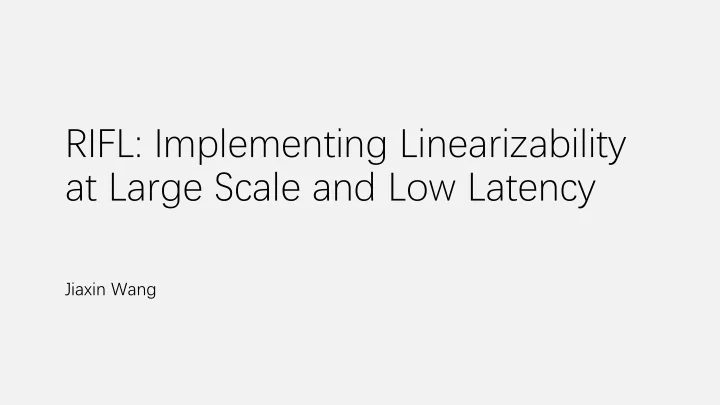

RIFL: Implementing Linearizability at Large Scale and Low Latency Jiaxin Wang
Motivation • Consistency • Important issue in large-scale storage systems • Linearizability • Strongest form of consistency for concurrent systems
Linearizability • A concurrent execution of transactions is equivalent to one that executes the transactions serially in some sequential order • The sequential order must preserve the real-time constraints of non-overlapping operations
Linearizability Non-linearizable Linearizable Reference: Manos Kapritsos, EECS 591 Distributed System, Lecture 9
Problem • Few large-scale storage systems implement linearizability today • What violates linearizability? • “ at-least-once semantics” (Re-execution of operations)
Solution - RIFL • R eusable I nfrastructure f or L inearizability • Ensure “ exactly-once semantics ” in large-scale systems • How? Reuse result generated by earlier execution for retries 3 • Reconfiguration tolerance • Scalability 3 • Low latency
RIFL Architecture • Assumption: Remote Procedure Call (RPC) mechanism • RIFL stores RPC results • For each retry • Do not re-execute • Return the stored result
RIFL Architecture Key Points • RPC identification • unique, managed by a lease mechanism • Completion record durability • RPC id and execution results included • Retry rendezvous • where to find the completion record • Garbage collection • when to delete a completion record
RPC Identification Client ID Sequence Number 64-bit integer 64-bit integer • • Unique system-wide Assigned by the client • Monotonically increasing
Completion Record Retries use the same RPC ID Client ID Sequence Number 64-bit integer 64-bit integer For retries, return the result without RPC Result re-execution Object Identifier Ensure migration durability
Retry Rendezvous • In a large-scale system, retry operations may not be sent to the same server as the original request • Data migration often occurs, maybe due to server crashes • Distributed operations involve multiple servers • Solution: associate each operation with a particular object • Completion record always stored in the same server as the object
Garbage Collection • Completion record eventually needs to be deleted • How does the server know it can be safely deleted? • Client acknowledges they have received the result • Server detects client crash (by a lease mechanism)
Design Details • RequestTracker • Manage sequence number • Run on client machines • LeaseManager • Manage client leases to detect client crashes • Run on both clients and servers • ResultTracker • Manage completion records • Run on server machines
Normal RPC Client Server Val: 2 W(0) ResultTracker: LeaseManager: ClientID = 1 RPC status = NEW RequestTracker: SeqID = 0 ClientID = 1, SeqID = 0 ObjectID = 3 time W(0) Success
Normal RPC Client Server Val: 0 W(0) ResultTracker: LeaseManager: ClientID = 1 RPC status = NEW RequestTracker: SeqID = 0 ClientID = 1, SeqID = 0 ObjectID = 3 time W(0) Success SeqID = 0, W(0) Success SeqID = 0, ACK
RPC Retry Client Server Val: 2 W(0) LeaseManager: ClientID = 1 ResultTracker: RPC status = FINISHED RequestTracker: SeqID = 0 ClientID = 1, SeqID = 0 ObjectID = 3 time W(0) Success SeqID = 0, W(0) Success SeqID = 0, ACK
RAMCloud Evaluation: Latency
RAMCloud Evaluation: Throughput
RAMCloud Evaluation: Scalability
Summary RIFL ensures “ exactly-once semantics ” to guarantee linearizability in large-scale systems with low latency
Q&A
Recommend
More recommend